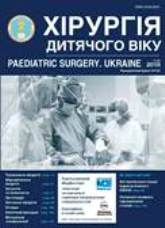Reasons of the diaphragmatic eventration relapse after cardiosurgery in children
DOI:
https://doi.org/10.15574/PS.2018.60.11Keywords:
congenital heart defect, postoperative complications, diaphragmatic eventration, relapseAbstract
Objective: to determine the rate of diaphragmatic eventration after the congenital heart defects (CHD) reconstruction in children, and to identify risk factors for the relapse of diaphragmatic eventration after its primary operation.
Materials and methods. A retrospective analysis of inpatient medical records at the Republican Scientific and Practical Centre of Paediatric Surgery (RSPCPS) in Minsk (the Republic of Belarus) during the period of 01/08/2018 to 01/01/2017 was conducted. The analysis of primary surgery protocols for the CHD correction, features of the postoperative course and methods of primary plastic surgery in diaphragmatic eventration was carried out. Statistical processing of the data was carried out using the MedCalc Version 17.6.
Results. During the analysed period, 6325 open heart operations were performed at the RSPCPS, and in 120 (1.8%) cases, the eventration of one of the diaphragm cupulas was observed in P/O period as complication. After the initial correction of diaphragmatic eventration, 12 (10%) out of 120 patients experienced a relapse, which required reoperation. The following statistical analysis of the data showed a significant increase in the number of relapses in the group of patients who underwent plastic surgery involving the use of U-shaped sutures on pads. In the group of patients transferred to spontaneous breathing in the first 12 hours after the operation, there were no relapses, while in group 2 (in which the time of breathing using the artificial ventilation was from 12 to 72 hours), the risk of relapse decreased 1.3 times as compared with patients of group 3, who needed respiratory support more than 72 hours. When applying «soft» regimens of the artificial ventilation, approximately a 4-time reduction of relapses was observed.
Conclusions. For the period from August 1, 2006 to January 1, 2017, the diaphragmatic eventration in the patients operated on CHD was diagnosed in 120 (1.8%) cases, which corresponds to literature data. Most likely the reason for the relapse of diaphragmatic eventration is the type and technique of the primary surgical intervention. Features of the postoperative course and artificial ventilation parameters in the patients after the primary plasty of the diaphragm with subsequent relapse of the disease are revealed. The choice of the optimal method of surgical correction of diaphragmatic eventration associated with a complex of postoperative management of patients will allow minimizing the number of relapses.
References
Abad P, Lloret J, Martinez Ibanez V, Patino B, Boix-Ochoa J. (2001). Diaphragmatic paralysis: Pathology at the reach of the pediatric surgeon. Circ Pediatr. 14: 21–24. PMid:11339114
Akay TH, Ozkan S, Gultekin B, Uguz E, Varan B, Sezgin A, Tokel K, Aslamaci S. (2006). Diaphragmatic paralysis after cardiac surgery in children: incidence, prognosis and surgical management Pediatric Surg. Int. 22(4): 341–346. https://doi.org/10.1007/s00383-006-1663-2; PMid:16518591
Amin Z, McElhinney DB, Strawn JK, Kugler JD, Duncan KF, Reddy VM et al. (2001). Hemidiaphragmatic paralysis increases postoperative morbidity after a modified Fontan operation. J Thorac Cardiovasc Surg. 122: 856–862. https://doi.org/10.1067/mtc.2001.118506; PMid:11689788
Celik S, Celik M, Aydemir B, Tunckaya C, Okay T, Dogusoy I. (2010). Long-term results of diaphragmatic plication in adults with unilateral diaphragm paralysis Celik et al. Journal of Cardiothoracic Surgery. 15; 5:111.
Dagan O, Nimri R, Katz Y, Birk E, Vidne B. (2006). Bilateral diaphragm paralysis following cardiac surgery in children: 10 year’s experience. Intensive Care Med. 32: 1222–1226. https://doi.org/10.1007/s00134-006-0207-5; PMid:16741697
Dube BP, Dres M. (2016). Diaphragm Dysfunction: Diagnostic Approaches and Management Strategies. J Clin Med. 5; 5(12) pii: E113.
Hines MH. Video-assisted diaphragm plication in children. (2003). Ann Thorac. Surg. 76: 234–236. https://doi.org/10.1016/S0003-4975(03)00682-9; https://doi.org/10.1016/S0003-4975(03)00129-2; https://doi.org/10.1016/S0003-4975(03)00177-2
Joho-Arreola AL, Bauersfeld U, Stauffer UG, Baenziger O, Bernet V. (2005). Incidence and treatment of diaphragmatic paralysis after cardiac surgery in children. Eur J Cardiothorac Surg. 27 (1): 53–57. https://doi.org/10.1016/j.ejcts.2004.10.002; PMid:15621471
Lemmer J, Stiller B, Heise G, Hubler M, Alexi-Meskishvili V, Weng Y et al. (2006). Postoperative phrenic nerve palsy: Early clinical implications and management. Intensive Care Med. 32: 1227–1233. https://doi.org/10.1007/s00134-006-0208-4; PMid:16741696
Ovroutski S, Alexi-Meskishvili V, Stiller B, Ewert P, Abdul-Khaliq H, Lemmer J et al. (2005). Paralysis of the phrenic nerve as a risk factor for suboptimal Fontan hemodynamics. Eur J Cardiothorac Surg. 27: 561–565. https://doi.org/10.1016/j.ejcts.2004.12.044; PMid:15784351
Zhang YB, Wang X, Li SJ, Yang KM, Sheng XD, Yan J. (2013). Postoperative diaphragmatic paralysis after cardiac surgery in management. Chin Med J (Engl). 126(21): 4083–4087.
Downloads
Issue
Section
License
The policy of the Journal “PAEDIATRIC SURGERY. UKRAINE” is compatible with the vast majority of funders' of open access and self-archiving policies. The journal provides immediate open access route being convinced that everyone – not only scientists - can benefit from research results, and publishes articles exclusively under open access distribution, with a Creative Commons Attribution-Noncommercial 4.0 international license(СС BY-NC).
Authors transfer the copyright to the Journal “PAEDIATRIC SURGERY.UKRAINE” when the manuscript is accepted for publication. Authors declare that this manuscript has not been published nor is under simultaneous consideration for publication elsewhere. After publication, the articles become freely available on-line to the public.
Readers have the right to use, distribute, and reproduce articles in any medium, provided the articles and the journal are properly cited.
The use of published materials for commercial purposes is strongly prohibited.

